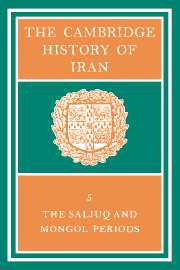Book contents
- Frontmatter
- 1 THE POLITICAL AND DYNASTIC HISTORY OF THE IRANIAN WORLD (A.D. 1000–1217)
- 2 THE INTERNAL STRUCTURE OF THE SALJUQ EMPIRE
- 3 RELIGION IN THE SALJUQ PERIOD
- 4 DYNASTIC AND POLITICAL HISTORY OF THE IL-KHĀNS
- 5 THE ISMĀ‘ĪLĪ STATE
- 6 THE SOCIO-ECONOMIC CONDITION OF IRAN UNDER THE ĪL-KHĀNS
- 7 RELIGION UNDER THE MONGOLS
- 8 POETS AND PROSE WRITERS OF THE LATE SALJUQ AND MONGOL PERIODS
- 9 THE VISUAL ARTS, 1050–1350
- 10 THE EXACT SCIENCES IN IRAN UNDER THE SALJUQS AND MONGOLS
- Bibliography
- Index
- Plate section
- References
9 - THE VISUAL ARTS, 1050–1350
Published online by Cambridge University Press: 28 March 2008
- Frontmatter
- 1 THE POLITICAL AND DYNASTIC HISTORY OF THE IRANIAN WORLD (A.D. 1000–1217)
- 2 THE INTERNAL STRUCTURE OF THE SALJUQ EMPIRE
- 3 RELIGION IN THE SALJUQ PERIOD
- 4 DYNASTIC AND POLITICAL HISTORY OF THE IL-KHĀNS
- 5 THE ISMĀ‘ĪLĪ STATE
- 6 THE SOCIO-ECONOMIC CONDITION OF IRAN UNDER THE ĪL-KHĀNS
- 7 RELIGION UNDER THE MONGOLS
- 8 POETS AND PROSE WRITERS OF THE LATE SALJUQ AND MONGOL PERIODS
- 9 THE VISUAL ARTS, 1050–1350
- 10 THE EXACT SCIENCES IN IRAN UNDER THE SALJUQS AND MONGOLS
- Bibliography
- Index
- Plate section
- References
Summary
The period of Iranian history covered in this discussion began with the rise of the Turkish dynasties of the Ghaznavids and of the Great Saljuqs and ended with the small Iranian or Mongol dynasties which followed and contributed to the fall of the Īl-Khānid empire. The specific dates quoted above are only approximations since stylistic and thematic changes do not necessarily coincide with major historical events, but the period as a whole is one in which all provinces of Islamic Iran and all media of artistic creation underwent considerable changes and in fact established architectural, formal, iconographic, and aesthetic standards which were to remain for many centuries thereafter those of Islamic Iranian art in general. This statement is valid in the sense that the arts of the following centuries can almost always be shown to be in a definable kind of relationship to forms, ideas, and techniques created or developed between the eleventh and the fourteenth centuries. Yet, if these filiations with later centuries can indeed be established, it is far more difficult to define the relationship of this art to that of previous centuries. In fact our documentation on and conceptual framework for the arts of the first four centuries of Islamic Iranian art are so limited and so much tied to the interpretation of a few texts or to purely accidental finds, that, with a few exceptions to be mentioned in due course, we will consider the art of Iran during the centuries under consideration as a new creation.
- Type
- Chapter
- Information
- The Cambridge History of Iran , pp. 626 - 658Publisher: Cambridge University PressPrint publication year: 1968
References
- 1
- Cited by

